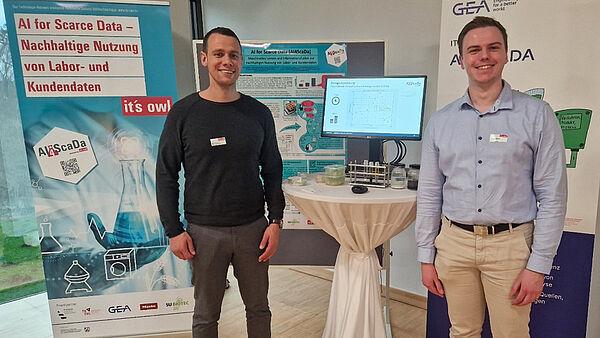Last year, the various use cases of AI4ScaDa were presented - a project that researches special AI techniques that can be used profitably in the context of scarce data. In contrast to big data, scarce data refers to little or incomplete, but often precise data. The challenge, however, is that AI systems are heavily dependent on the quality and quantity of the data. If very little data is available, many AI processes cannot keep up with human expertise.
First results of the research project
This year, the presentation focused on the first tangible results. Thanks to intensive research work and close cooperation between the industrial partners GEA, SU BIOTEC an Miele and the research institutes Institute for Industrial Information Technology (inIT) and Center for Applied Data Science Gütersloh (CfADS), impressive progress has been made. Key results include the development and implementation of space-filling experimental designs for the recording of scarce data, which can optimize categorical parameters as well as numerical variables, and the creation of a data set with uncertainties in the labels.
While the AI4ScaDa project continues to pursue its ambitious goals, one thing remains clear: the future of industrial automation will be significantly shaped by artificial intelligence. Initiatives like this play a crucial role in shaping that future.
Space-filling experimental designs with categorical parameters
Space-filling experimental designs enable companies to efficiently investigate factors and their interactions. By varying several parameters simultaneously in a few experiments, companies can save resources, optimize processes, reduce costs, accelerate product development and create a better basis for decision-making. Overall, space-filling experimental designs help companies to improve their research and development processes and become more competitive.
However, often only numerical factors are optimized. However, the project partners also have categorical factors that also need to be optimized. In the case of project partner GEA, for example, this is the color of the separated substances or the type of products to be separated in the separators or decanters. At SU BIOTEC, it is the type of fertilizer or lighting used for plant cultivation, and at Miele it is the type of dryer program used, among other things. There is therefore a need for space-filling experimental designs with categorical variables for the targeted recording of scarce data.
Data set with uncertainties
Another focus is on applying spatial categorical design of experiments to a larger data set for product design at GEA. The data set is currently being labeled by experts. The special feature here is that not only static labels, but also uncertainties or uncertainties are recorded. The experts say exactly how confident they feel about the label or whether they are unsure about a particular example. This additional information can be harnessed using AI methods for information fusion. Information fusion is the process of combining information from different sources, such as sensor data or expert knowledge, to provide a more holistic view. The aim is to improve the quality, accuracy and reliability of information in order to make informed decisions.
Christoph-Alexander Holst, head of the research group in the Discrete Systems working group of Prof. Dr. Volker Lohweg at inIT, emphasizes the importance of the results: "So far, there are only a few data sets that contain large amounts of fuzziness in labels. With our research work in AI4ScaDa, we are closing this gap and enabling us and the research community to optimize and validate AI methods with regard to these blurs."
Project link:
Link to the last strategy meeting:
https://www.init-owl.de/aktuelles/news/detail/ai4scada-auf-der-its-owl-strategietagung-2023/
Link to a more detailed description of the use cases:


